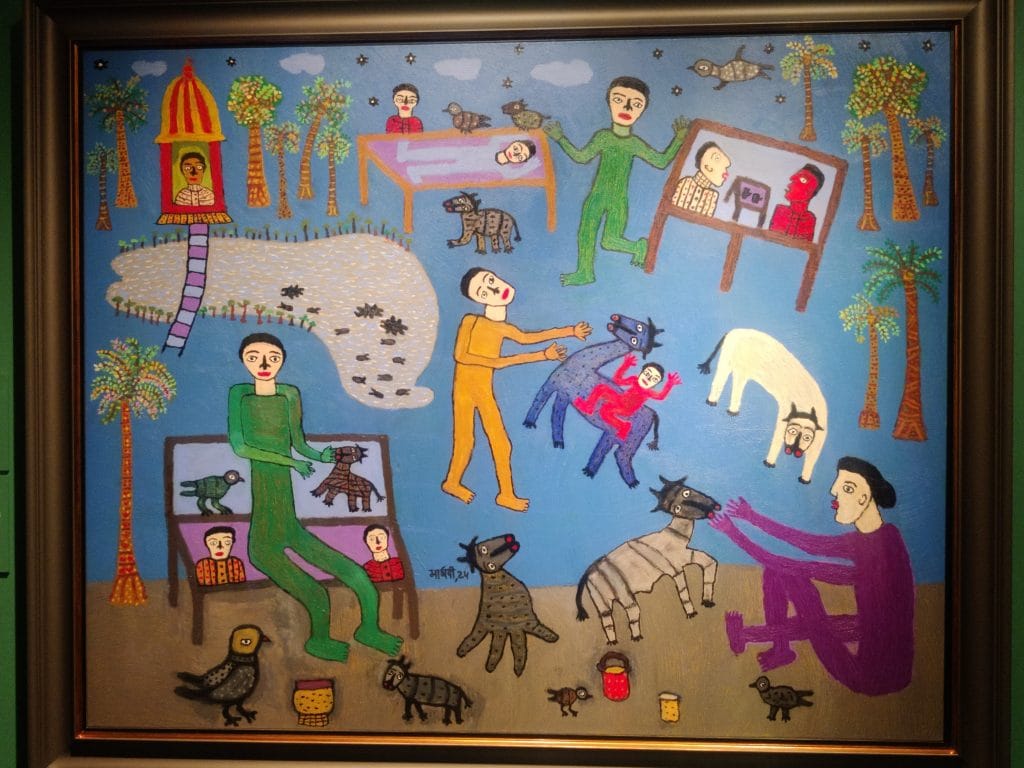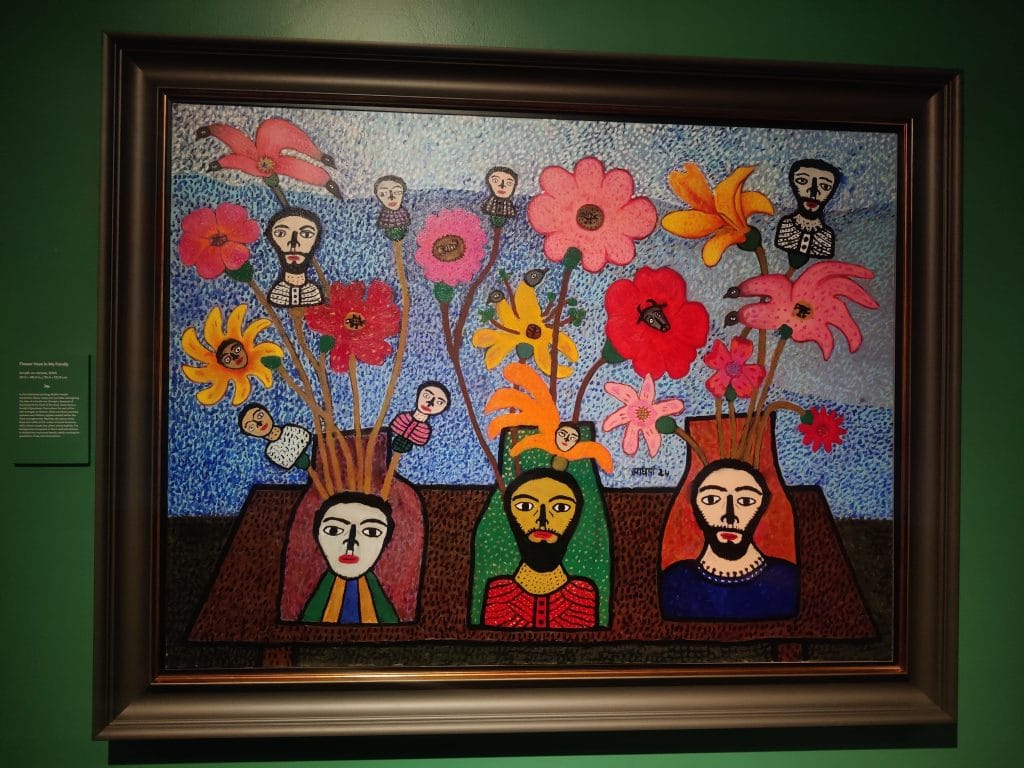New Delhi: In Two Scarecrows in My Rice Field, artist Madhvi Parekh transforms a simple rural scene into a whimsical world. Two towering figures—a traditional scarecrow and a fantastical multi-limbed tortoise—stand as gentle guardians, attracting rather than frightening birds and creepy-crawlies. They fill every corner, from the field to tiny shrines, weaving a vibrant, fable-like ecosystem where nothing exists alone.
The ongoing exhibition Madhvi Parekh: Remembered Tales at the DAG gallery in Delhi features over 20 new paintings created between 2020 and 2025. It’s on view until 23 August. The show celebrates the magic in the ordinary—where memory, drawn with love, transforms into myth. Despite exhibiting at global venues like the Venice Biennale and her work being collected by the Metropolitan Museum of Art, New York, 83-year-old Parekh remains an artist in her own time, deeply rooted in her personal story. Without formal art training, she patiently and playfully brings her inner world to life without chasing trends.
Born in 1942 in Sanjaya, Gujarat, Parekh’s work is rich with stories and symbols drawn from close observation and lived experience. Her early exposure to artists like Paul Klee and Joan Miró—through her husband and artist Manu Parekh—also shaped her style. But she never imitated them. Klee’s use of lines, dots, and shapes merged seamlessly with the rangoli patterns and sacred geometries of her rural upbringing, shaping her distinct, evolving voice.
“She’s lived in cities—Bombay, Calcutta, and New Delhi for the past 40 years. But despite being a progressive modern woman, her art world isn’t urban; it’s rural and simple. Her work feels timeless, untouched by buildings, roads, or cars. Trees, water, and creatures carry that eternal quality. Her paintings are more about a playful, open world than a fixed storyline,” art critic Kishore Singh told ThePrint.

Also read: This art exhibition in a Delhi mall wants shoppers to make the right choices
Circus, childhood, and flights of fancy
Travelling Circus in My Village is a joyful, chaotic celebration of the circuses that visited her village as a child. Back then, there were no televisions. Entertainment came in the form of Ram Leela performances, Bhavai dancers dressed in saris, Behrupiyas in disguise, and travelling circuses with trapeze artists, elephants and horses.
The painting is full of movement and imagination. Birds, beasts and humans blur together—snakes with human faces, centipedes with animal heads, and creatures who appear half-man, half-monster. It’s as if Parekh never left the tent of her childhood circus, carrying its magic into adulthood.
In another painting, Pond in My Village, she creates a layered, affectionate portrait of rural life. The painting is a bustling patchwork of small yet vivid vignettes–a man resting on a woven charpoy, and a child playing with a goat.

In the top left of the composition lies a bridge stretching across the pond, leading to a temple, inspired by the grand Swaminarayan temple in Vadtal, where young Madhvi once studied. The temple is not just a religious site but a familiar figure in the visual and emotional landscape of her village. Around it, human figures coloured in the tones of purple, green and yellow, roam through a land where earth and sky merge into one.
Here, humans and animals coexist seamlessly–neither dominates the other, and each element feels equally valued.
“Everything, from ladders to cushions, holds meaning and forms a relationship with us. She honours these everyday objects, urging us to respect and value all things around us. This reverence and interconnectedness are at the heart of her work,” said Singh about Parekh’s paintings.
Also read: Delhi exhibition traces 130 yrs of children’s book illustrations. Satyajit Ray to Priya Kurian
A personal visual language
Her artistic journey began in the 1960s, when she was a young, pregnant mother. Her early work is filled with figures, fantasy elements, and toys. As her career progressed, she turned to memories of her village, vividly bringing its characters and scenes to life.
“Devi, a form of Shakti, is portrayed not as a religious icon but with a playful, imaginative spirit. Her art blurs boundaries–demons like Mahishasur taking the form of a snake, housing countless stories within. Has this demon eaten this human? Or is it creating something new in its world? Layers upon layers—stories, regeneration—the world is rich and interconnected,” said Singh, pointing to Parekh’s painting Goddess.
Parekh’s art is also deeply shaped by her spiritual and cultural surroundings. Living in Kolkata during her husband’s posting at the Weavers Service Centre, she immersed herself in Durga and Kali pujas. These experiences later blossomed into paintings like Goddess Durga, Goddess Kali and Ganesha in a Boat.
In her version of Goddess Durga, a bold red figure with long black hair dominates the canvas, flanked by mythical creatures and surrounded by delicately boxed patterns, reminiscent of sari borders or embroidered bedsheets from her youth.

In Flower Vase in My Family, 2024, Parekh turns flower vases into family portraits, blending blooming forms with birds, bees, and hybrids against a textured sky.
Her paintings merge the sacred with the whimsical. Her goddesses are fierce but also joyful. Her approach to colour is instinctive, shaped by years of walking through mustard fields, watching sunsets, and admiring the colours of the rainbow after monsoon showers. Her characters often have clove-like noses, their heads popping out of flower stalks or forming blooms themselves, like in Flower Vase in My Family.
“I didn’t know how to draw noses, so I started making them this way,” Parekh said with a smile.
(Edited by Theres Sudeep)






